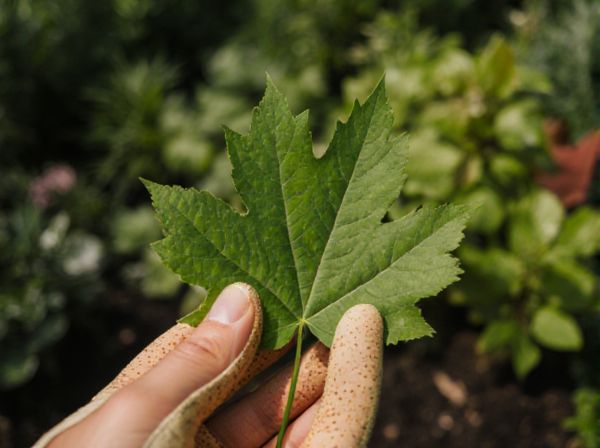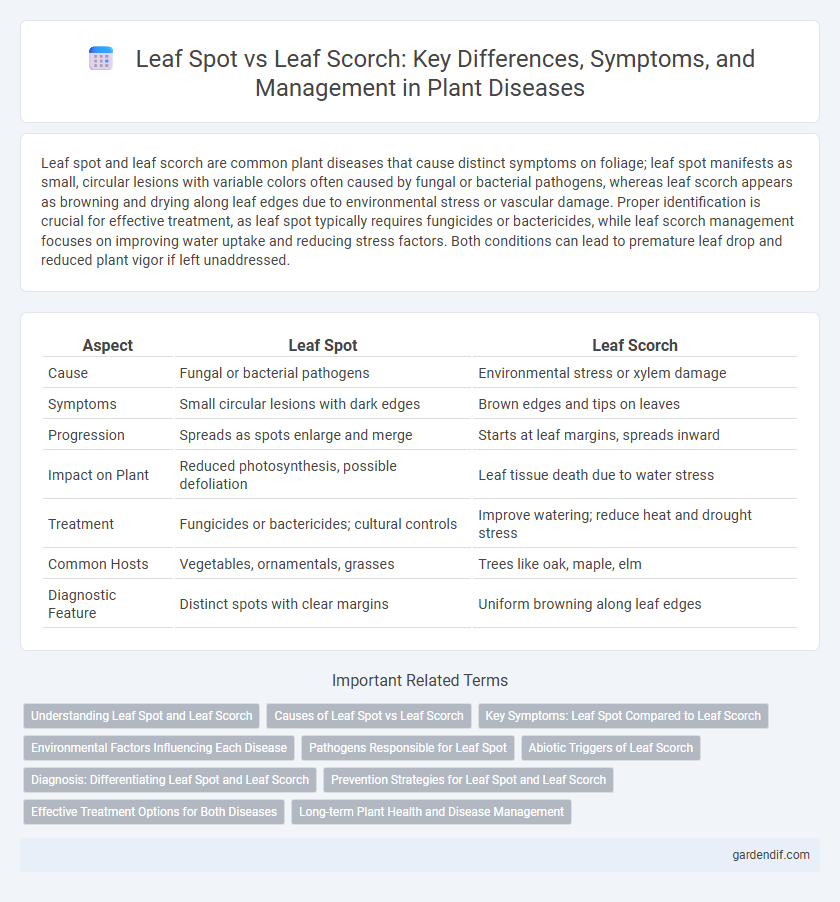
Leaf spot vs Leaf scorch Illustration
Leaf spot and leaf scorch are common plant diseases that cause distinct symptoms on foliage; leaf spot manifests as small, circular lesions with variable colors often caused by fungal or bacterial pathogens, whereas leaf scorch appears as browning and drying along leaf edges due to environmental stress or vascular damage. Proper identification is crucial for effective treatment, as leaf spot typically requires fungicides or bactericides, while leaf scorch management focuses on improving water uptake and reducing stress factors. Both conditions can lead to premature leaf drop and reduced plant vigor if left unaddressed.
Table of Comparison
| Aspect | Leaf Spot | Leaf Scorch |
|---|---|---|
| Cause | Fungal or bacterial pathogens | Environmental stress or xylem damage |
| Symptoms | Small circular lesions with dark edges | Brown edges and tips on leaves |
| Progression | Spreads as spots enlarge and merge | Starts at leaf margins, spreads inward |
| Impact on Plant | Reduced photosynthesis, possible defoliation | Leaf tissue death due to water stress |
| Treatment | Fungicides or bactericides; cultural controls | Improve watering; reduce heat and drought stress |
| Common Hosts | Vegetables, ornamentals, grasses | Trees like oak, maple, elm |
| Diagnostic Feature | Distinct spots with clear margins | Uniform browning along leaf edges |
Understanding Leaf Spot and Leaf Scorch
Leaf spot and leaf scorch are common plant diseases that affect foliage by causing discoloration and damage. Leaf spot is characterized by small, round, discolored lesions often caused by fungi or bacteria, whereas leaf scorch results from environmental stress such as drought or heat, leading to browning and drying of leaf edges. Accurate identification is crucial for effective treatment, with leaf spot managed through fungicides and cultural practices, while leaf scorch requires improving water management and reducing stress factors.
Causes of Leaf Spot vs Leaf Scorch
Leaf spot is primarily caused by fungal or bacterial pathogens such as Cercospora, Septoria, or Xanthomonas, which produce distinct spots on the leaf surface due to infection and tissue damage. Leaf scorch results from environmental stress factors including drought, nutrient deficiencies, or salt toxicity that disrupt water transport, leading to browning and drying of leaf margins. Accurate identification of these causes is essential for effective disease management and prevention strategies.
Key Symptoms: Leaf Spot Compared to Leaf Scorch
Leaf spot causes distinct, round to irregularly shaped lesions on leaves, often with dark borders and centers that may be tan, brown, or black, indicating fungal or bacterial infection. In contrast, leaf scorch presents as irregular browning or yellowing along leaf margins and between veins, usually resulting from environmental stress or vascular issues. Key symptoms of leaf spot include localized spots with a defined edge, while leaf scorch shows diffuse discoloration and tissue death without distinct spots.
Environmental Factors Influencing Each Disease
Leaf spot disease often develops in conditions of high humidity and frequent rainfall, which promote fungal spore germination and infection on leaf surfaces. Leaf scorch, conversely, is typically triggered by environmental stressors such as drought, excessive heat, and high wind, which cause water deficiency and damage to leaf tissues. Understanding these distinct environmental factors aids in accurately diagnosing and managing each disease effectively in agricultural and horticultural settings.
Pathogens Responsible for Leaf Spot
Leaf spot is primarily caused by fungal pathogens such as Cercospora, Alternaria, and Septoria species, which infect plant tissues leading to circular or irregular lesions on leaves. These pathogens thrive in warm, moist environments and produce spores that spread via water splashes, infecting new leaves. Unlike leaf scorch, which results from abiotic stress like drought or nutrient deficiencies, leaf spot is directly linked to infectious agents causing localized tissue damage.
Abiotic Triggers of Leaf Scorch
Leaf scorch is primarily caused by abiotic triggers such as drought stress, soil salinity, and root damage, which impair water uptake and lead to desiccation of leaf tissues. High temperatures combined with low humidity exacerbate this condition by increasing transpiration rates and causing cellular dehydration. Unlike leaf spot, which is driven by fungal or bacterial pathogens, leaf scorch symptoms arise without pathogen presence and result from environmental stress factors disrupting plant water relations.
Diagnosis: Differentiating Leaf Spot and Leaf Scorch
Leaf spot is characterized by distinct, often circular or irregularly shaped lesions with clear margins caused by fungal or bacterial pathogens, while leaf scorch presents as uniform browning or drying along leaf edges due to environmental stress or vascular disease. Diagnosis involves examining lesion patterns, presence of fungal structures under a microscope, and assessing environmental conditions to rule out non-pathogenic causes. Confirmatory tests like pathogen culturing or molecular assays help distinguish leaf spot infections from the physiological symptoms of leaf scorch.
Prevention Strategies for Leaf Spot and Leaf Scorch
Preventing leaf spot involves selecting resistant plant varieties, maintaining proper spacing for air circulation, and applying fungicides during wet conditions to inhibit fungal growth. Leaf scorch prevention requires consistent watering practices to avoid drought stress, mulching to retain soil moisture, and avoiding damage to roots and bark that can impair water uptake. Regular monitoring and early intervention are critical for managing both leaf spot and leaf scorch effectively.
Effective Treatment Options for Both Diseases
Effective treatment options for leaf spot involve applying fungicides containing chlorothalonil or copper-based compounds to inhibit fungal growth and removing affected leaves to reduce spore spread. Leaf scorch treatments focus on improving plant hydration through consistent watering, enhancing soil quality with organic mulch, and applying anti-transpirants to minimize water loss. Both diseases benefit from proper pruning practices and maintaining optimal nutrition to strengthen plant resistance.
Long-term Plant Health and Disease Management
Leaf spot diseases, caused by various fungal and bacterial pathogens, typically result in localized lesions that can be managed with timely fungicide applications and improved air circulation to prevent spread, thereby preserving long-term plant health. In contrast, leaf scorch, often triggered by environmental stressors such as drought, heat, or root damage, requires strategies focused on optimizing irrigation, improving soil health, and reducing plant stress to enhance resilience and reduce susceptibility to secondary infections. Effective disease management integrates regular monitoring, accurate diagnosis, and tailored treatment plans to mitigate chronic damage and maintain overall plant vitality over multiple growing seasons.
Leaf spot vs Leaf scorch Infographic

 gardendif.com
gardendif.com